Bob Reid’s Railway Revolution is a story about the life and career on the railway of Sir Robert Basil Reid and the history of the railways since nationalisation.
Published in October 2021 by Unicorn Publishing and written by George Muir, this paperback book measures around 241 mm x 168 mm, and has 224 pages.
It has a published price of £25.00 but can be purchased from Amazon for £15.00.
Sir Robert Basil Reid was always known as Bob Reid One, as his successor was also named Sir Robert Paul Reid, but with the middle name of Paul instead of Basil.
The aim of the book is to show how the organisational changes he introduced during his time as the Chairman of the British Railway Board from 1983 to 1990 turned British Rail into one of the best railways in Europe.
This book is not simply the story of a famous British Rail chairman, but the history of Britain’s railway through the 20th century, including its highs and lows.
It discusses the constant search for the right governance and structures, and the battles between innovation and bureaucracy which continue today.
The story of how Bob Reid rose through the ranks to become a remarkable leader who transformed British railways from a struggling industry to a world-class service includes the history of the railways from their origins to their present state, highlighting the challenges and achievements along the way.
The author’s division of the book into four parts seems rather strange. Part One introduces Bob Reid’s early life and his railway career until 1974, and also describes the history of British railways in general until 1960. Part Two strays from the book’s subject as it goes on to describe events on the railway from 1960 to 1980, without mentioning Bob Reid.
Part Three overlaps Part Two as it resumes Bob Reid’s story from 1974 and his role in the railway leading to his appointment as Chairman in 1983. Part Four seems superfluous as it is a postscript that covers the period after Bob Reid’s retirement.
The parts of the book that are concerned with Bob Reid show how he rose from a humble trainee to become the head of the British Railways Board.
It describes his achievements and challenges in managing one of the most complicated and contentious industries in Britain, but also shows his insights and vision for the future of rail transport, as well as his personal life and interests outside the railways.
There are a few illustrations in the book as well as a number of graphs, tables, and maps. However, the maps in general are rather indistinct, such as the one below showing the six British Railways regions.
The original map was obviously colour-coded to aid understanding, but as it has been reproduced in black-and-white its legibility has been lost.
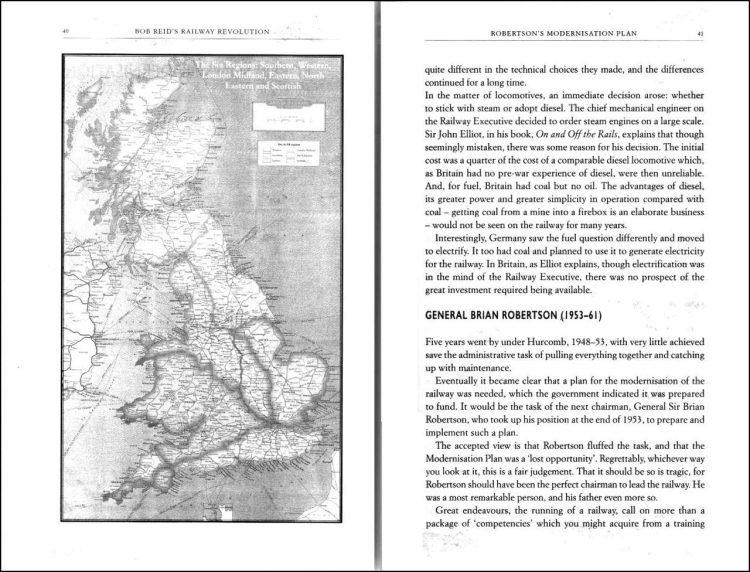
The photo below shows Ludwig Erhardt, who became the German Minister for Economic Affairs in 1948 and is included in a chapter describing German Railways. However, it is difficult to understand why a chapter on German Railways merits inclusion in this book.
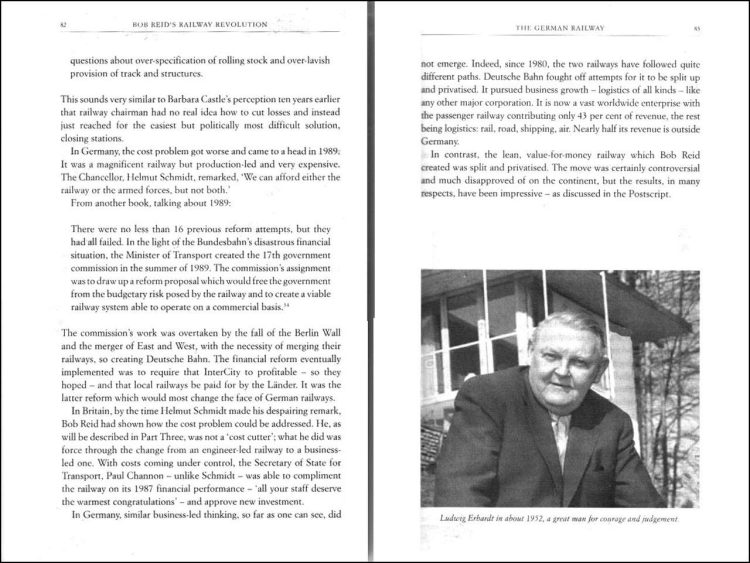
The pages below are from a chapter about Barbara Castle’s tenure as Minister of Transport and show a picture of Sir Henry Johnson, who became the Chairman of the British Railways Board in 1968.
However, as the author admits in his Introduction, this chapter is not related to Bob Reid’s time in office and has no bearing on the book’s aim which is to show how Bob Reid transformed Britain’s railways to be the best in Europe.
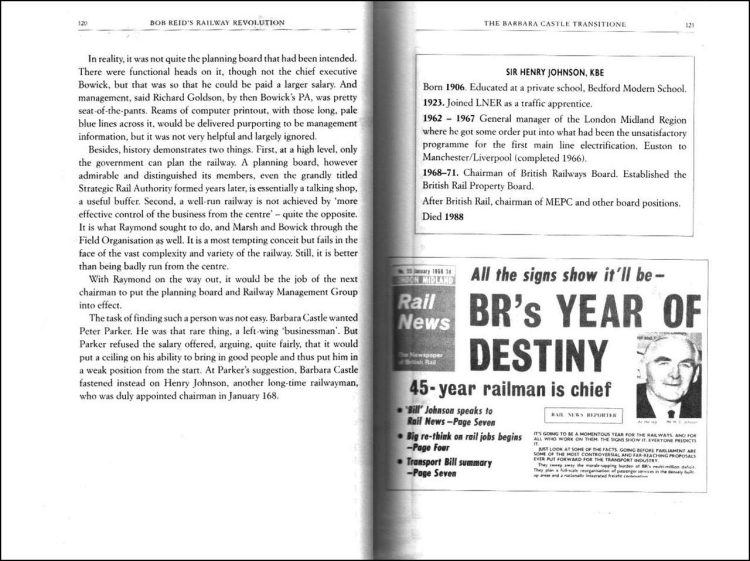
The photograph below is from a chapter on railway signalling and shows a photo of what is claimed to be the world’s first failsafe microcomputer. This device was used to implement digital signalling, a revolutionary technology that improved the safety and efficiency of railway operations.
Although this historical artefact is intriguing, it does not relate to the main topic of the book, which is Bob Reid’s career and achievements on the railway. The author could have omitted this photograph and focused more on Reid’s personal and professional experiences.
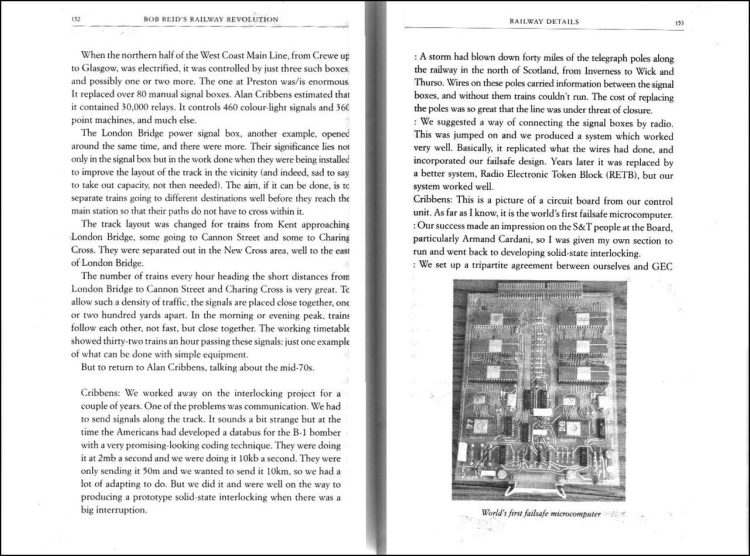
Following on from the previous photograph is the one below of what in 1957 was a state-of-the-art signal box at Three Bridges.
Nowadays, the signal control centre at Three Bridges is a modern facility that uses computerised systems and CCTV cameras to monitor and manage railway traffic.
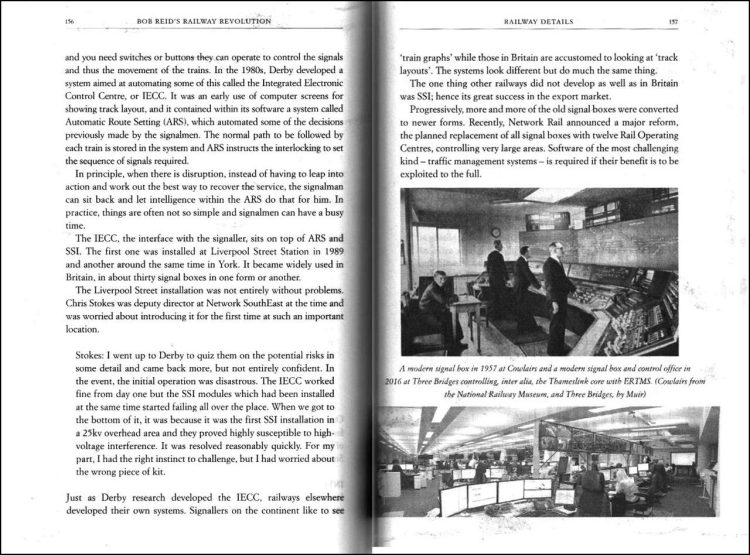
The book includes an eight-page section of colour photos of ex-British Railways staff mentioned in the book. It would have been useful if the captions also included their positions in the organisation during Bob Reid’s tenure.

George Muir’s book about Bob Reid’s Railway Revolution is a fascinating account of how one man transformed the British rail industry in the 1980s.
The author tells the story of how Reid, as the chairman of British Rail, introduced radical changes to improve efficiency, customer service and safety, and the challenges and controversies that he faced, such as the privatisation of the railways, the fatal accidents at Southall and Ladbroke Grove, and the political pressures from the government and the public.
Although the book is obviously well-researched and is written in an engaging style with plenty of anecdotes and insights from Reid and other key players, it is oddly organised with Reid only being the subject in Parts One and Three, whilst in Parts Two and Four the author talks about other aspects of the railways.
Part Two should especially be mentioned as it accounts for one-quarter of the book’s content yet does not include anything relating to Reid.
There are many quotes from people who knew Bob and from railway literature in general, with the best bits being about Bob’s life with many quotes from his daughter.
The inclusion of a chapter about German railways seems irrelevant, as is a summary of the privatised period that followed Bob’s death.
Mention must be made of the illustrations, as their reproduction quality isn’t in keeping with the book’s cover price as they are no better than what would be expected in a medium-price paperback book.
Also, the maps have been so far over-reduced in size that any attempt at studying them, even with a magnifying glass, is impossible.
A book worth reading for the detail on Bob Reid’s life and career, but many chapters are irrelevant and only serve to confuse what could have been a concise history of this Chairman of the British Railways Board.
The book is available to purchase from Amazon.
RailAdvent would like to thank Unicorn Publishing for providing it with a copy of the book for review.






Responses
Best in Europe?
Britain’s railways haven’t been the best in Europe since the 1930s and that’s a bit of a stretch, but certainly never post war!
The non-Bob Reid sections of the book are interesting in and of themselves and may at least provide some background, but I agree that they are not essential for understanding the book’s main subject. The book is however of great interest in that it describes the career of someone who was effective in developing the Intercity passenger services in the teeth of Government indifferance and obstruction.
Fast forward to 2023 to the privatised shambolic railway of today!
Definitive works on a interesting subject like Bob Reid which haven’t been covered in proper detail before should be in hardback and should avoid the temptation of repeating at length more well-known facts and background which are either well-known to or easily found by its potential purchasers. Thank you for an honest and useful review.